Fibonacci Series Program Using Function in PHP
A Fibonacci series program using functions in PHP is a script that generates a sequence where each n
Fibonacci Series Program Using Function in PHP
A Fibonacci series program using functions in PHP is a practical way to demonstrate the power of modular coding and algorithm development. By encapsulating the sequence generation within a function, developers can easily reuse and adapt the code for different input sizes or incorporate it into larger applications. This approach also enhances understanding of fundamental programming concepts such as loops, recursion, and function calls. Learning to implement the Fibonacci sequence with functions not only boosts problem-solving skills but also provides a strong foundation for developing more complex algorithms and improving code organization in PHP projects, which is beneficial for students and professionals alike.
To Download Our Brochure: https://www.justacademy.co/download-brochure-for-free
Message us for more information: +91 9987184296
A Fibonacci series program using functions in PHP is a practical way to demonstrate the power of modular coding and algorithm development. By encapsulating the sequence generation within a function, developers can easily reuse and adapt the code for different input sizes or incorporate it into larger applications. This approach also enhances understanding of fundamental programming concepts such as loops, recursion, and function calls. Learning to implement the Fibonacci sequence with functions not only boosts problem solving skills but also provides a strong foundation for developing more complex algorithms and improving code organization in PHP projects, which is beneficial for students and professionals alike.
Course Overview
This course teaches how to generate the Fibonacci series using functions in PHP, covering fundamental programming concepts, function creation, and sequence logic, enabling learners to build efficient, reusable code for mathematical series and algorithms.
Course Description
Learn how to generate the Fibonacci series in PHP using functions with this course. It covers creating reusable functions, understanding sequence logic, and applying efficient programming techniques to build mathematical sequences in PHP.
Key Features
1 - Comprehensive Tool Coverage: Provides hands-on training with a range of industry-standard testing tools, including Selenium, JIRA, LoadRunner, and TestRail.
2) Practical Exercises: Features real-world exercises and case studies to apply tools in various testing scenarios.
3) Interactive Learning: Includes interactive sessions with industry experts for personalized feedback and guidance.
4) Detailed Tutorials: Offers extensive tutorials and documentation on tool functionalities and best practices.
5) Advanced Techniques: Covers both fundamental and advanced techniques for using testing tools effectively.
6) Data Visualization: Integrates tools for visualizing test metrics and results, enhancing data interpretation and decision-making.
7) Tool Integration: Teaches how to integrate testing tools into the software development lifecycle for streamlined workflows.
8) Project-Based Learning: Focuses on project-based learning to build practical skills and create a portfolio of completed tasks.
9) Career Support: Provides resources and support for applying learned skills to real-world job scenarios, including resume building and interview preparation.
10) Up-to-Date Content: Ensures that course materials reflect the latest industry standards and tool updates.
Benefits of taking our course
Functional Tools
1 - PHP Development Environment: For implementing the Fibonacci series program using functions, a robust PHP development environment is essential. Students are guided to set up tools like XAMPP, WAMP, or MAMP, which include Apache server, PHP, and MySQL, providing an integrated platform for coding and testing their scripts locally. These environments simulate real server conditions, ensuring that students understand deployment considerations from the start. Installing and configuring these tools helps students become comfortable with server management and debugging PHP code effectively. The environment allows real time testing, which accelerates learning by providing immediate feedback on code modifications. It also enables students to work seamlessly with other web technologies, fostering practical skills for web development projects.
2) Code Editor or IDE: A text editor or integrated development environment like Visual Studio Code, Sublime Text, PHPStorm, or NetBeans is used for writing and managing PHP scripts efficiently. These editors offer features such as syntax highlighting, code completion, error detection, and debugging tools that simplify coding complex functions. Students learn to organize their code neatly and ensure readability through these tools, helping them develop maintainable programming habits. Many IDEs also provide plugins and extensions tailored for PHP development, enhancing productivity and reducing the time required to troubleshoot errors. They offer code snippets and templates which can speed up the process of creating functions for sequence generation, making the learning curve smoother.
3) Version Control Systems: Git and platforms like GitHub or GitLab are introduced as essential tools for managing code versions. During the Fibonacci program training, students learn how to track changes, revert to previous code states, and collaborate with peers through version control. This fosters disciplined development practices and helps in managing different iterations of their code. Understanding version control is vital for working in teams, especially during larger projects or real world software development environments. By practicing commit, push, pull, and merge operations, students develop skills that are crucial for maintaining robust, defect free codebases and facilitating continuous integration processes.
4) Debugging Tools: Built in features of IDEs, such as debugging consoles and breakpoints, are emphasized to teach students how to identify and fix errors in their PHP code. These tools allow step by step execution and variable inspection, which are invaluable for understanding complex recursive or iterative Fibonacci algorithms. Debugging skills are critical for resolving logical errors and optimizing code performance, especially as programs grow in complexity. Guided exercises help students familiarize themselves with error messages and common pitfalls, improving their troubleshooting capabilities. This hands on approach ensures that students can confidently resolve issues on their own and develop a deeper understanding of program execution flow.
5) Web Browsers: Modern web browsers like Google Chrome, Mozilla Firefox, or Microsoft Edge are utilized to run and test PHP scripts through local servers. Students learn to access their PHP files via URLs, simulating real world web application interactions. Browser developer tools further assist in diagnosing frontend issues when their Fibonacci sequences are displayed on webpages, integrating PHP backend logic with frontend presentation. This comprehensive testing environment helps students see the immediate impact of their code modifications, fostering an interactive learning experience. Loading and debugging code in browsers also prepares students for deploying PHP applications in live environments, where frontend backend connectivity is fundamental.
6) Documentation and Learning Resources: Online platforms, official PHP documentation, tutorials, forums, and educational websites serve as vital tools for reinforcing concepts learned during the course. Students are encouraged to explore these resources to understand functions, syntax, and best practices in PHP. Accessing detailed documentation helps clarify uncertainties and deepens their understanding of language features relevant to Fibonacci implementation. Additionally, community forums enable peer support, troubleshooting assistance, and sharing of innovative solutions. Continuous engagement with these learning tools empowers students to become independent learners and proficient programmers capable of problem solving beyond the classroom.
7) Project Management Tools: For organizing their Fibonacci programming projects, students may use project management and note taking tools like Trello, Asana, or simple digital notebooks. These tools assist in planning the development process, setting milestones, and tracking progress through various stages of designing, coding, testing, and debugging. Learning to manage their projects systematically ensures that students develop disciplined work habits and can handle multiple tasks efficiently. Proper project organization aids in documenting their code logic, making it easier for reviews or future enhancements. Such skills are vital for professional software engineering roles where project planning and documentation are critical.
8) Auxiliary Libraries or PHP Extensions: While the core PHP language is sufficient for Fibonacci series programs, students might explore additional PHP libraries or extensions that facilitate advanced calculations or streamline development. For example, mathematical extension libraries can optimize recursive calculations or handle large number computations more efficiently. Familiarity with such tools broadens students' capabilities and prepares them for complex real world problems involving numerical algorithms. Using extensions or libraries also introduces them to PHP’s extensibility and integration with external modules, which is essential for developing scalable, high performance web applications.
9) Testing Tools and Frameworks: Simple testing frameworks like PHPUnit are introduced to teach students how to automate testing of their Fibonacci functions. By writing test cases, students learn to validate their code’s correctness systematically, reducing bugs and ensuring stability. Testing frameworks facilitate test driven development practices, which are highly valued in industry environments. These tools help students understand the importance of writing clean, reliable code from the start and enable them to efficiently maintain and enhance their programs as projects evolve.
10) Continuous Learning Platforms: E learning platforms offering courses, tutorials, and webinars on PHP programming are recommended as supplemental tools for ongoing skill development. Platforms such as Coursera, Udemy, and Khan Academy provide updated lessons on PHP best practices, advanced algorithms, and web development trends. These resources motivate students to deepen their understanding, explore new features, and stay current in the evolving tech landscape. Integrating continuous learning tools ensures that students not only complete the Fibonacci program course but also build a strong foundation for future advanced projects and professional growth.
11 - Code linting and formatting tools: Tools like PHP_CodeSniffer and PHP CS Fixer are introduced to help students maintain consistent coding styles and adhere to best practices. Proper code formatting enhances readability and reduces errors caused by inconsistent indentation or syntax issues. Automating code style checks encourages discipline and professionalism, which are essential in collaborative development environments. These tools can be integrated into IDEs, providing real time feedback and ensuring code quality throughout the project lifecycle.
12) Database Management Tools: Although a Fibonacci program may not inherently require a database, integrating tools like phpMyAdmin or MySQL Workbench introduces students to data storage concepts. For more advanced projects, storing sequence data or results can demonstrate persistent data handling. Learning to connect PHP with databases prepares students for building dynamic web applications that require data management, expanding their web development capabilities.
13) Containerization Platforms: Platforms like Docker can be used to create isolated environments for PHP development. Introducing students to containerization ensures consistency across different development setups and simplifies deployment processes. Docker images configured with necessary PHP versions and dependencies provide a reliable environment, especially useful when working on multiple projects or transitioning from development to production.
14) Automated Deployment Tools: Familiarity with tools like Jenkins or GitHub Actions introduces students to continuous integration and continuous deployment (CI/CD) pipelines. Automating testing, building, and deploying Fibonacci projects or related applications teaches best practices for maintaining production quality code. This knowledge is vital for understanding how software is managed in real world enterprise environments.
15) Learning Management Systems (LMS): Using LMS platforms such as Moodle or Canvas can facilitate structured coursework dissemination, quizzes, and assignments. These systems help in tracking student progress, providing feedback, and fostering interactive learning environments. Incorporating LMS tools enhances the educational experience and supports scalable training programs.
16) Online Code Collaboration Platforms: Tools like CodePen or Replit enable real time collaboration and sharing of PHP scripts. Students can experiment together, review each other's code, and learn from peer feedback. These platforms promote collaborative coding practices and enhance communication skills vital for team based development scenarios.
17) Cloud Hosting Services: Introducing services like AWS, DigitalOcean, or Azure allows students to deploy their PHP Fibonacci programs on live servers. Understanding cloud hosting opens avenues for deploying scalable web applications, managing domain configurations, and ensuring security compliance. Cloud experience prepares students for real world deployment challenges and operational best practices.
18) Profiling and Performance Analysis Tools: Tools such as Xdebug or Blackfire can be used to analyze the efficiency of Fibonacci algorithms, especially as they grow in complexity. Learning to optimize recursive or iterative code enhances performance and reduces resource consumption. Mastery of profiling tools is essential for developing high performance applications and understanding bottlenecks.
19) Security Testing Tools: Basic security testing tools help students understand vulnerabilities such as injection or cross site scripting (XSS). Incorporating security considerations into Fibonacci projects emphasizes the importance of writing secure code, which is vital when these scripts are integrated into broader web applications.
20) Community and Support Platforms: Participation in developer communities like Stack Overflow, PHP forums, and social media groups provides ongoing support, industry insights, and networking opportunities. Engaging with these communities encourages problem solving, staying updated on PHP trends, and fostering lifelong learning habits essential for professional growth.
Browse our course links : https://www.justacademy.co/all-courses
To Join our FREE DEMO Session:
This information is sourced from JustAcademy
Contact Info:
Roshan Chaturvedi
Message us on Whatsapp: +91 9987184296
Email id: info@justacademy.co












